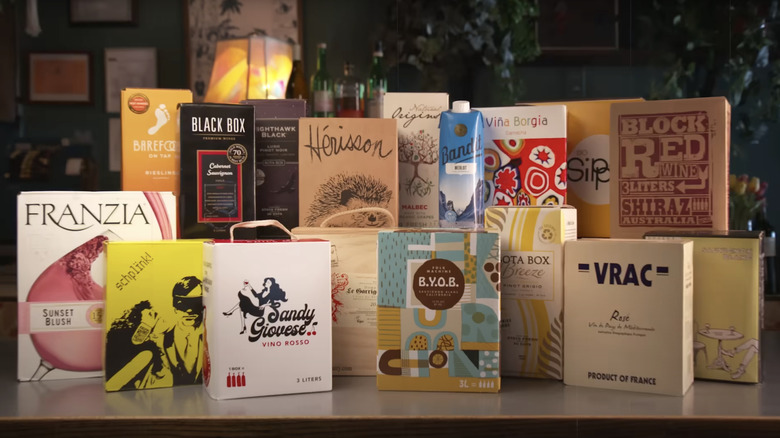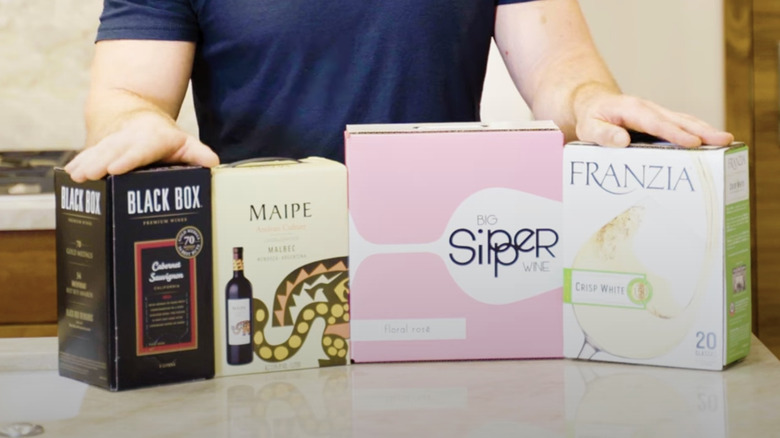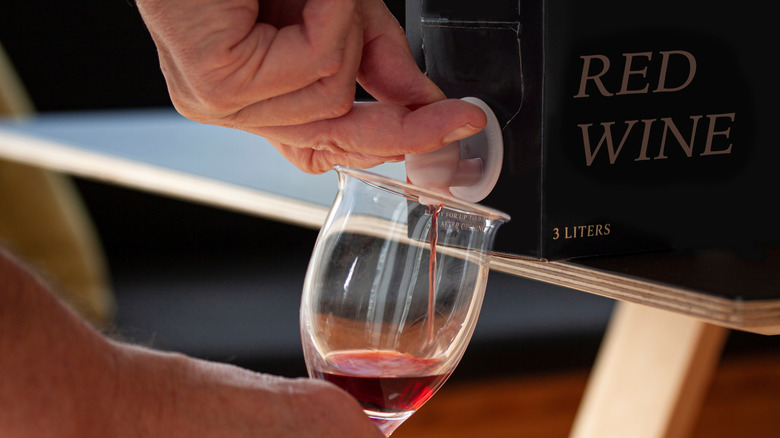What Are The Advantages Of Boxed Wine Over Bottled?
Sometimes you've had a long day, and you just want to have a glass of wine and relax. And sure, unopened red wine lasts longer than you might think, but once you pop the cork, the rest will go stale within a few days. Boxed wine solves that problem in an easy and effective way once you get past the idea that it might be inferior. Food Republic reached out to Megumi Calver, sommelier and founder of Merobebe, who explained, "One of the best features of boxed wine is its longevity! It can stay fresh for up to six weeks after opening."
According to Calver, the packaging's innovative design is the reason for the wine's extended freshness. The wine is "sealed inside a collapsible vacuum bag within the box," which dramatically reduces its exposure to oxygen — the main culprit behind spoilage and flat-tasting wine. This slows down the oxidation process, making a noticeable difference in the wine's quality over time.
This system also changes how people approach everyday drinking. For someone who only wants a glass or two during the week, it removes the guilt of tipping stale wine down the drain or keeping it and drinking wine that tastes mediocre. Calver pointed out that most boxes hold "the equivalent of four standard bottles," which means you can pour a small glass on a Tuesday night without worrying about waste. The packaging also makes it easy to serve a crowd without opening multiple bottles and then enjoy any leftovers as you please without a strict timeframe.
Boxed wine has evolved from cheap to quality
For years, boxed wine was shorthand for low-quality, mass-produced plonk — the kind that showed up at college parties and never impressed anyone. That image is harder to shake than the reality because the format itself has changed drastically. As Megumi Calver bluntly puts it, "This isn't the Franzia-and-Red-Solo-Cup era anymore." In recent years, winemakers have recognized that convenience doesn't have to come at the expense of quality. They've started producing boxed wines with well-sourced grapes, handled with the same care as their bottled versions, and the results, according to Calver, are "clean, fresh, as well as inexpensive."
Perception has begun to evolve, particularly with younger drinkers "who value convenience and sustainability," Calver notes. They'll gladly buy a box of a highly-rated budget cabernet sauvignon and enjoy a drink — no shame attached. That shift matters because it shows boxed wine isn't just surviving on affordability; it's carving out a place as a serious option for everyday enjoyment. As Calver says, "The industry is starting to catch up." Producers are beginning to lean into the format's strengths rather than treating it as an afterthought.
More wine for less money and a lower footprint
Convenience and quality aren't the only advantages boxed wine has over bottled. There's also a very practical side, which is price and environmental impact. Megumi Calver explains, "From a sustainability standpoint, boxed wine has a significantly lower carbon footprint." She points out how the box avoids the heavy glass, corks, screw caps, and labels that come with traditional packaging. Because it doesn't weigh as much and has a more compact shape, it takes less energy to ship, and with many brands using recycled cardboard, it lessens overall waste.
Then there's the savings at checkout. "You're getting more wine at a lower cost per glass," Calver says — and that adds up. Unfortunately, out of all the hurdles that remain for people to take boxed wines seriously, people thinking it looks tacky to have at anything other than a low-class shindig is hard to get over in the court of public opinion. However, far from being a second-tier option, boxed wine now delivers an approachable, sustainable, and cost-effective way to enjoy wine on your own terms.



